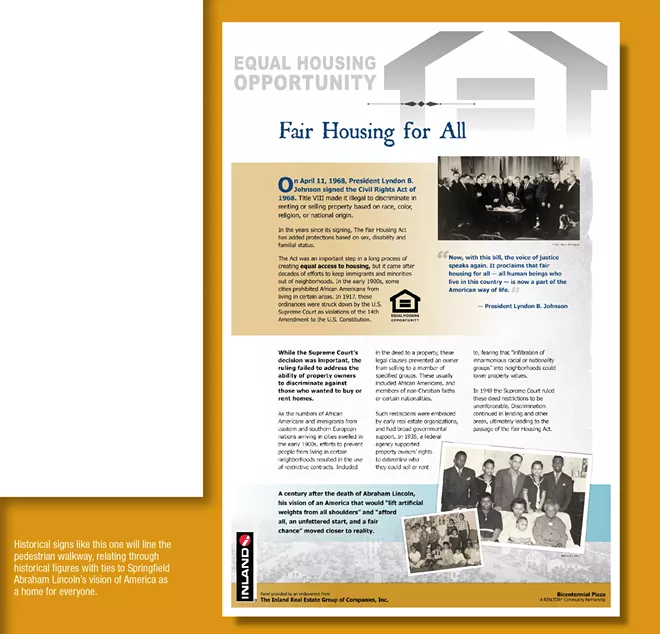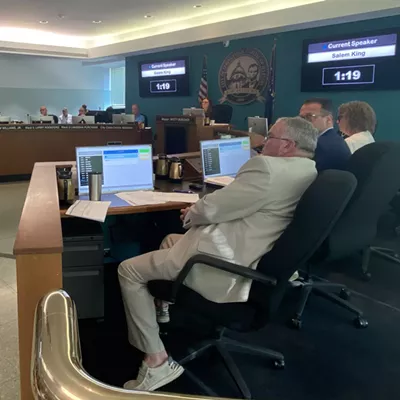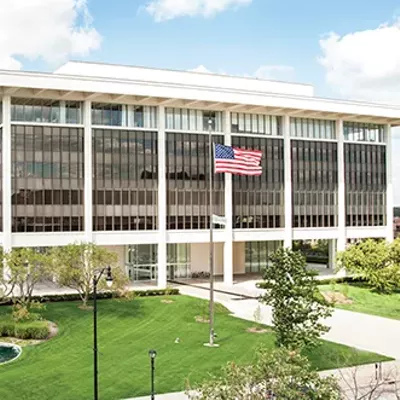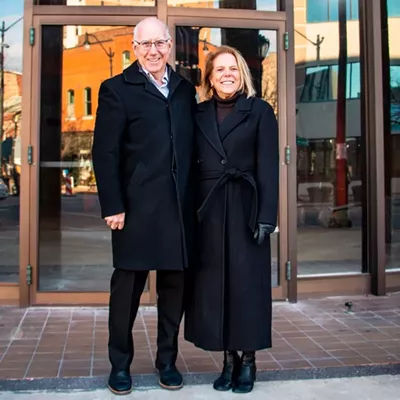By Rachel Johnson
Fifty years ago on April 11, President Lyndon B. Johnson signed the Fair Housing Act, making it illegal to discriminate in renting or selling property based on race, color, religion or national origin. Illinois and Chicago, in particular, were key areas struggling for equality at the time. With the swell of immigrants at the turn of the century and the increasing diversity of the United States, there was pressure to keep ethnic and religious groups together in their own neighborhoods. In more than one case, the Supreme Court had declared these practices to be illegal, but with the Civil Rights movement in full swing and the assassination of Martin Luther King, Jr. on April 4, Johnson deemed it time to make a statement.
However, discrimination in lending and real estate didn’t end overnight at the stroke of a pen. Recognizing this, the Illinois Realtors have decided to erect a six-foot-tall, granite monument commemorating the 50th anniversary. “It’s a reminder that it wasn’t always easy or available, and there’s still a lot of work to be done,” Illinois Realtors CEO Gary Clayton said.
Realtors must learn about the Fair Housing Act as part of their training now. “If you go back to 90-91, continuing education was passed for Realtors and a statutory requirement was Fair Housing training,” Clayton said.
According to Clayton, there have been plenty of battles fought in housing over the years. The headquarters for Illinois Realtors is located on Fifth Street, directly across from the Illinois Governor’s Mansion with a fine view of the Capitol and the Y-Block, where presumably a park will be added in the future. Right now, there is construction visible from every window. The Executive Mansion is being renovated and will be open to the public on July 14. As part of Illinois’ year-long bicentennial celebration, Illinois Realtors are finally moving on a project they’ve been urged to consider since construction of their headquarters in 2007. “We acquired the bank building lot first and then two parking lots, and once we had acquired that property, I was frequently visited by members of the community about Jackson Street,” Clayton said.
Springfield is working toward creating its own Freedom Trail of sorts, providing walkways and signage for tourists to move between the Lincoln sites and the Capitol and Executive Mansion without having to get in their cars and negotiate one-way streets. Originally asked to create a pedestrian walkway along Jackson Street, Illinois Realtors decided to take it one step further. “With the bicentennial, it gave us the opportunity to be a little larger thinking,” Clayton said.
Jackson Street is a natural corridor between the Capitol and Lincoln sites. Crossing Fifth Street on the east side of the Executive Mansion puts you into what was recently a parking lot, but is effectively Jackson Street. “Since it was never platted, we own it,” Clayton said.
Keeping their portion of Jackson Street for pedestrians only, Illinois Realtors will be creating a legacy project, turning it into Bicentennial Plaza using a combination of private funds, donations and $1 million in TIF money from the city. This space will feature 16 20-foot-tall towers, each telling a story relating to Abraham Lincoln’s vision of America as a home for everyone, regardless of race or religion.
Historical figures with ties to Springfield will include well-known figures such as abolitionist Frederick Douglass and others less well-known, such as Frances D. Gage, who fought for equal rights for women. The Fair Housing Act and the Springfield Race Riot of 1908 will also have markers.
Illinois Realtors has worked closely with the Department of Natural Resources and local historians to not only select individuals and their stories, but to ensure accuracy of the information. Each panel will include photos and information about the person or event. As part of this walkway’s dedication on Aug. 2, Illinois Realtors will host a panel discussion open to the public.
“The interpretive signage and design of the Bicentennial Plaza will help provide a southern link for what the SDAT report called ‘The Springfield Way,’ an easily-understood pedestrian walk linking many of our historic treasures. We need to continue to make more visual connections like this throughout the downtown area. A walkable experience is not only more enjoyable but actually has been proven to increase window shopping and, ultimately, purchases, which is important for the sustainability of our business district,” Downtown Springfield, Inc. executive director Lisa Clemmons Stott said.
Coming up soon is Lobby Day on Tuesday, April 10, so Illinois Realtors will be dedicating their granite monument to Fair Housing on Monday, April 9. The monument states simply, “50 years of the Fair Housing Act – Title VIII of the Civil Rights Act, the Fair Housing Act, prohibits housing discrimination. It was signed into law on April 11, 1968.” They have invited members, several elected officials, and the regional administrator of Housing and Urban Development from Chicago to come to the third-floor event room in their headquarters to enjoy the festivities.











